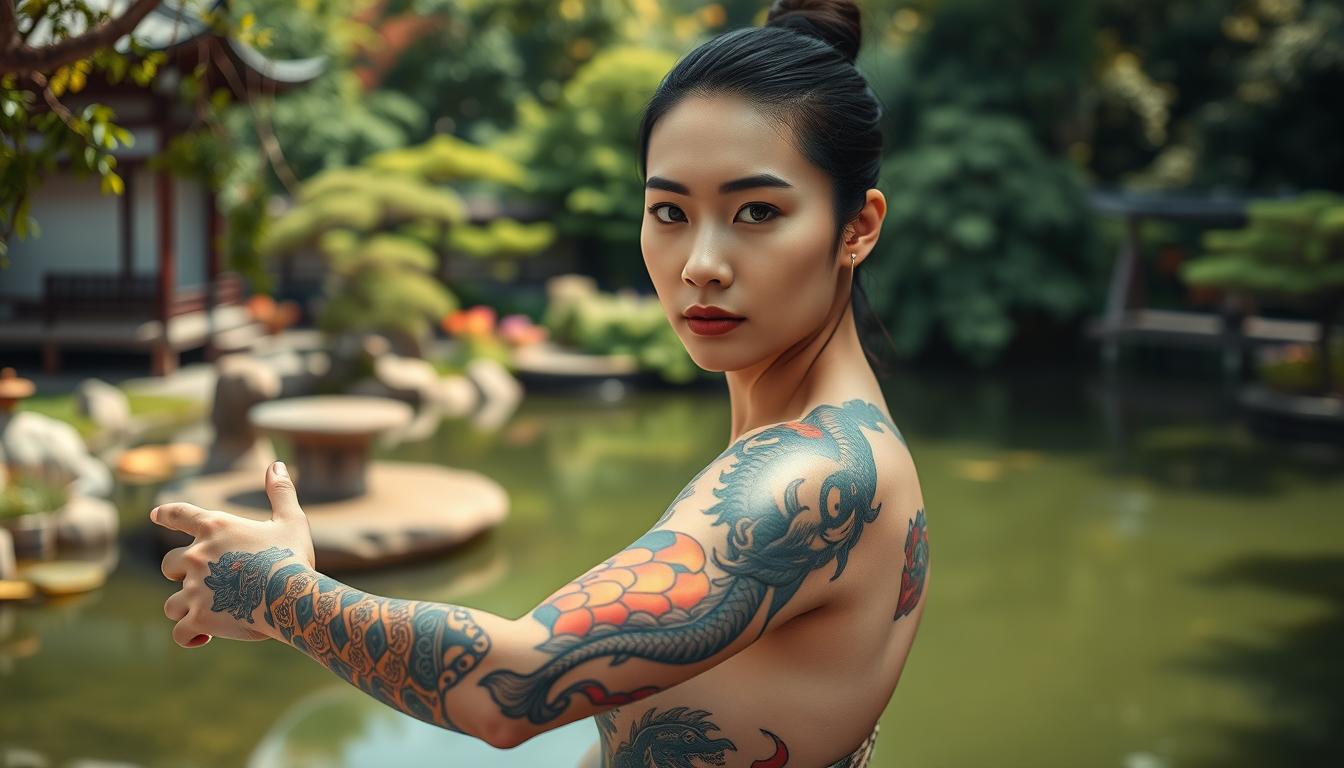
What if the art on your skin could get you banned from a hot spring? This surprising reality reveals the complex relationship between body ink and cultural norms in a society where tradition often clashes with modern self-expression.
While over 30% of American adults proudly wear body art, attitudes here tell a different story. Historical ties to organized crime have created lasting stigmas, yet younger generations are quietly rewriting the narrative. You’ll find breathtaking craftsmanship in studios blending centuries-old methods with contemporary designs.
Visitors often face unexpected challenges – from restricted spa access to curious stares. But beneath these surface tensions lies a rich artistic legacy. Traditional irezumi masters spend years perfecting their craft, creating wearable stories that honor nature and folklore.
How does a nation balance deep-rooted traditions with global influences? Your journey through this evolving landscape will uncover surprising truths about respect, rebellion, and the power of ink to transform perceptions.
Key Takeaways
- Body art carries historical stigma but gains modern acceptance among youth
- Traditional Japanese designs feature nature motifs and symbolic storytelling
- Public spaces often restrict access to those with visible ink
- Artists preserve hand-poked techniques while embracing new styles
- Cultural sensitivity remains crucial for international guests
History and Cultural Origins of Japanese Tattoos
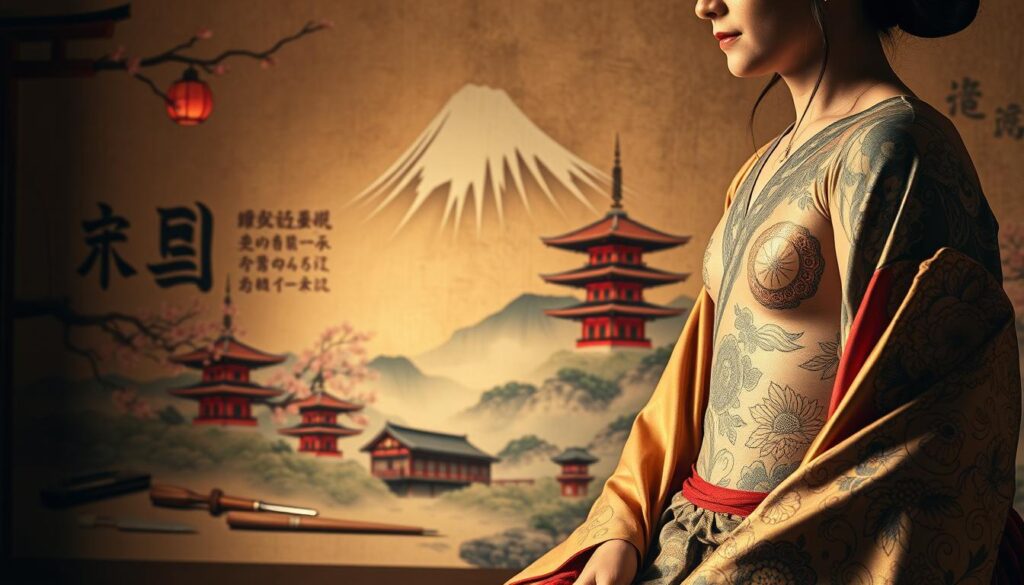
Imagine uncovering clay figures from 12,000 years ago that reveal humanity’s oldest conversations with skin art. Archaeologists found these Jomon Period relics marked with intentional patterns – early evidence of body modifications that blended spiritual meaning with personal decoration.
Ancient Beginnings and Early Practices
What began as sacred symbols took a dark turn by 720 A.D. Authorities started branding criminals with forehead markings – permanent shame that shaped society’s view for centuries. You’ll notice this punishment system created deep-rooted associations between body art and wrongdoing.
Surprisingly, the 17th century brought stricter bans despite ending penal tattoos. This paradox forced the practice underground, where it quietly evolved into something unexpected.
The Transformation During the Edo Period
Everything changed when Chinese novels like Suikoden arrived. Their illustrated heroes covered in vibrant designs sparked a cultural revolution. Firefighters and laborers adopted full-body artwork as badges of honor, their intricate patterns hiding a secret language of resilience.
During this time, traditional methods gained artistic prestige through painstaking hand-poked techniques. Though associated with organized groups later, these historical developments laid the foundation for modern styles that balance beauty with complex social meanings.
Modern Attitudes and Evolving Trends
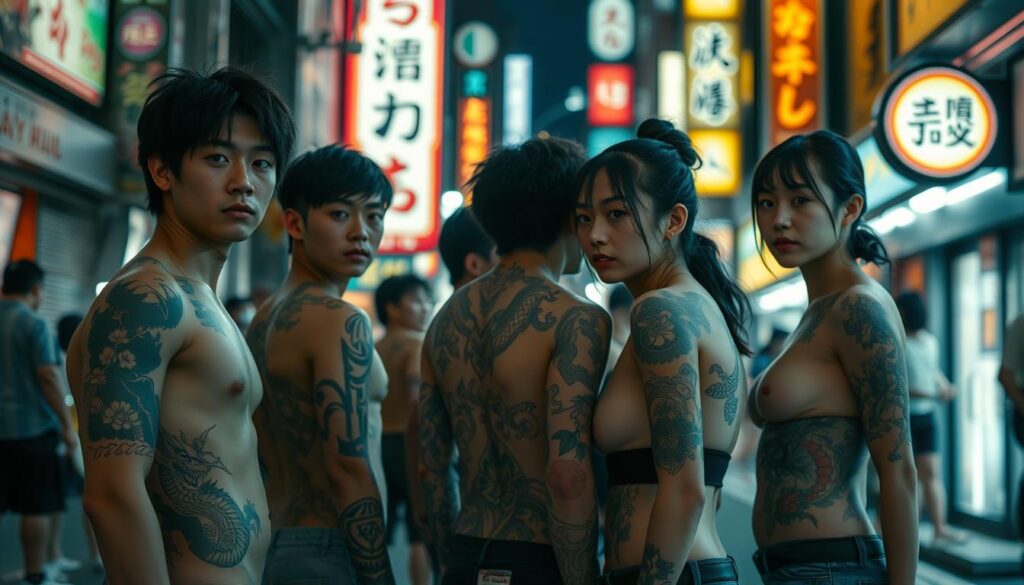
Why do fashion-forward districts like Harajuku buzz with colorful sleeve designs that would’ve caused outrage 30 years ago? The answer lies in a cultural revolution reshaping perceptions of body art across generations.
Cultural Shifts and Generational Perspectives
You’ll find grandparents and teenagers living in parallel worlds when it comes to skin ink. Older Japanese people often recall TV dramas where full-body designs signaled gang affiliation. “Those images stuck like sumi ink,” says Tokyo sociologist Akira Tanaka. “Many still associate body art with danger.”
Millennials and Gen Z tell a different story. Over 60% of artists under 35 report increased demand for small, meaningful designs. Floral patterns and minimalist symbols now outnumber traditional full-back pieces in urban studios.
International Influence on Local Views
Globalization brought fresh perspectives through:
- Foreign celebrities showcasing intricate artwork
- Instagram trends celebrating ink as wearable art
- Cultural exchange programs highlighting diverse meanings
You’ll notice most Japanese people approach visitors with curiosity rather than judgment. A 2022 survey revealed 78% of residents under 30 believe body art should be allowed in public baths when worn by international guests. This acceptance grows as studios blend traditional methods with global styles – think watercolor koi fish meeting geometric patterns.
While stigma hasn’t fully disappeared, creative expression now outweighs outdated stereotypes in fashion capitals. The needle of progress keeps moving, stitching together respect for heritage with modern self-identity.
Understanding Tattoos in Japan
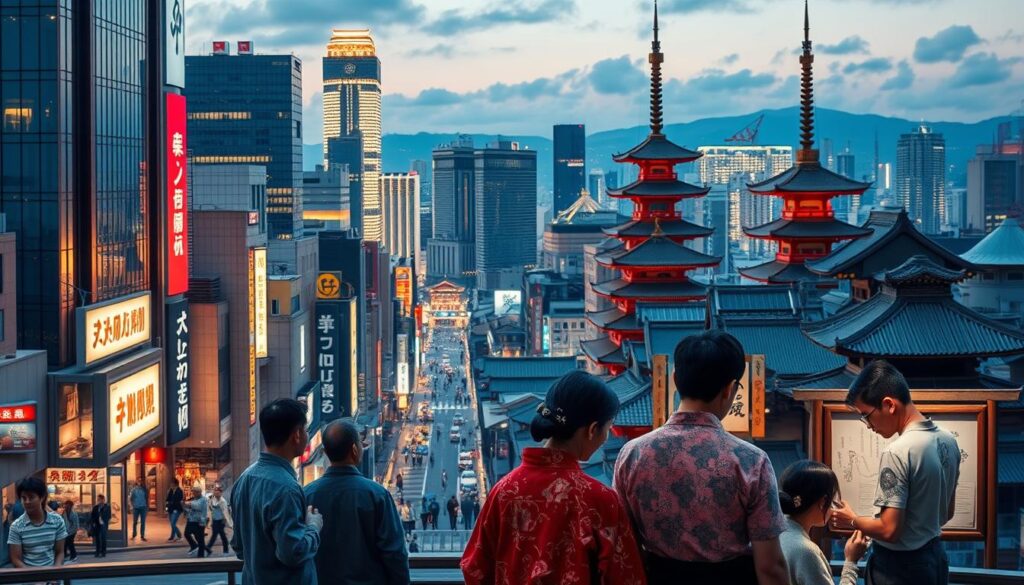
Did you know getting inked could land an artist in legal trouble? Japan’s complex relationship with skin designs stretches back to 1872, when authorities banned all body modifications to project modernity. This 71-year prohibition forced practitioners underground, cementing associations between the art form and rebellion.
Legal Gray Areas and Artistic Freedom
Though legalized in 1948, confusion persists. The Ministry of Health shocked creators in 2001 by declaring needlework a medical procedure – requiring doctors’ licenses for practitioners. Artist Taiki Masuda’s 2015 arrest highlighted this clash, his 300,000 yen fine sparking debates about creative rights.
Recent changes offer hope. Since 2020, professionals can operate without medical credentials under specific conditions. But many locals still hesitate – 43% associate body art with organized groups according to a 2023 survey. You’ll find studios often use discreet signage to avoid scrutiny.
This evolving landscape shows how traditions shape modern rules. While customers face no restrictions, artists navigate delicate balances between expression and compliance. Your awareness of these nuances helps respect both the craft and cultural sensitivities.
Navigating Tattoo Stigma and Etiquette
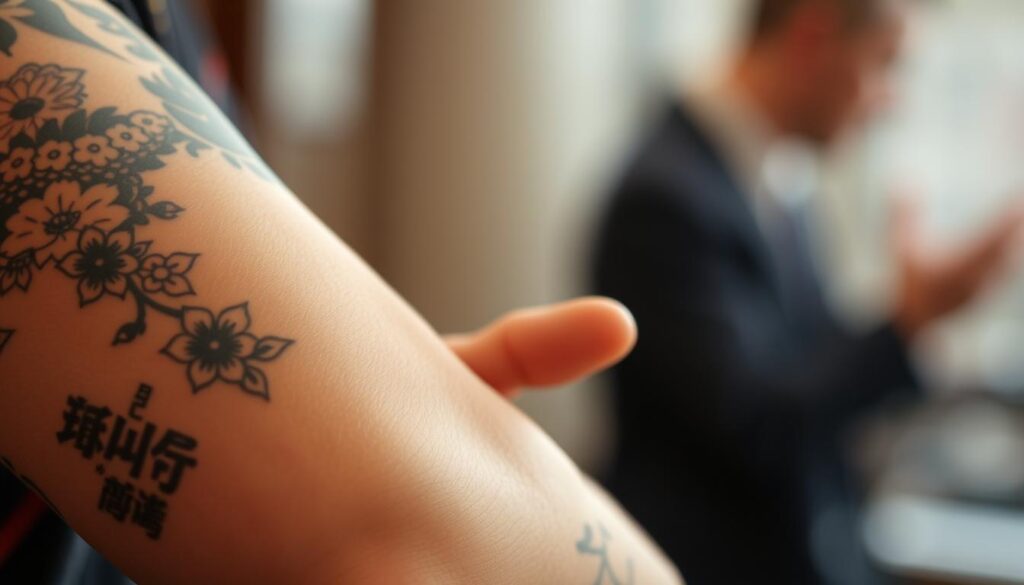
Picture this: You’ve planned the perfect trip, only to face closed doors because of your ink. Many establishments maintain strict policies rooted in cultural history, requiring thoughtful preparation to balance self-expression with respect.
When Tradition Meets Personal Style
Businesses often associate body art with outdated stereotypes, despite growing acceptance among younger generations. A 2023 survey found 68% of traditional ryokan inns still refuse entry to guests with visible designs. “Cover-up strategies show you value cultural norms,” explains etiquette expert Mari Kobayashi.
Carry these essentials to navigate sensitive spaces:
- Breathable arm sleeves for hot days
- Waterproof concealer from local pharmacies
- Lightweight scarves for sudden policy changes
Workplace Wisdom
Corporate environments remain particularly conservative. The Osaka mayor’s 2012 call to fire employees with body art reflects lingering stigma in client-facing roles. Many companies require full coverage through:
Practical solutions:
- High-collared shirts for neck designs
- Wristbands hiding forearm artwork
- Makeup matching your skin tone
Always research facilities beforehand – some progressive gyms offer private shower stalls, while select beaches designate tattoo-friendly zones. Your flexibility demonstrates cultural awareness, opening doors to richer experiences.
Travel Considerations for Tattooed Visitors
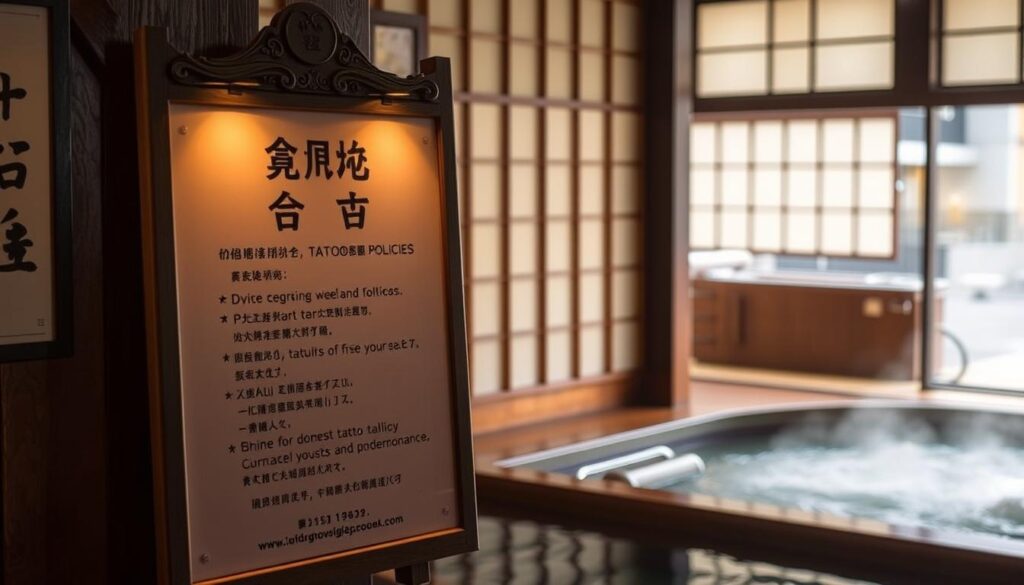
Stepping into a steaming hot spring might require more planning than you expect. Many traditional bathhouses maintain strict policies, but creative solutions let everyone enjoy these cultural treasures. Recent changes show growing flexibility while respecting local customs.
Onsen, Public Baths, and Other Facilities
Your relaxation plans need smart strategies. Private bathing options remove all stress – over 40% of ryokan inns now offer reservable personal hot springs attached to guest rooms. These secluded facilities provide complete privacy without compromising tradition.
| Facility Type | Access Policy | Best For |
|---|---|---|
| Private Onsen | Unrestricted | Guaranteed entry |
| Public Baths (with patches) | Under 5cm designs | Small artwork |
| Tattoo-Friendly Towns | Full access | Social experience |
Kinosaki Onsen revolutionized accessibility by welcoming all visitors at its seven public bathhouses. “We want travelers to experience our healing waters without hesitation,” says town spokesperson Yumi Sato. This Hyogo Prefecture destination leads Japan’s shift toward inclusive tourism.
Three essential tips enhance your experience:
- Purchase waterproof cover-ups at Matsumoto Kiyoshi stores
- Book early morning slots at mixed-use facilities
- Verify policies through official websites
Always confirm rules before visiting japan – some resorts update policies seasonally. With thoughtful preparation, you’ll soak in relaxation rather than stress.
Getting Inked in Japan: Artistry and Techniques
Have you ever watched ink become part of someone’s story? Tokyo’s studios blend cutting-edge technology with ancestral methods, creating spaces where body art transforms into lifelong masterpieces.
Modern Studios Meet Global Standards
You’ll find world-class facilities like Three Tides Tattoo and Bright Side Tattoo staffed by bilingual artists. These spaces prioritize hygiene and comfort, using single-use needles and premium pigments. Popular creators book months ahead – plan early to secure your spot.
Time-Honored Craftsmanship
The traditional Japanese tebori method uses hand-carved bamboo tools to layer colors gradually. Many clients report this 18th-century technique feels like cat scratches rather than machine vibrations. Masters specialize in symbolic creatures and natural elements, each stroke carrying cultural weight.
Whether choosing electric needles or manual tools, your experience connects to generations of artists pushing boundaries. Respect the craft by researching designs and preparing for multiple sessions – true traditional Japanese pieces often unfold across years.
